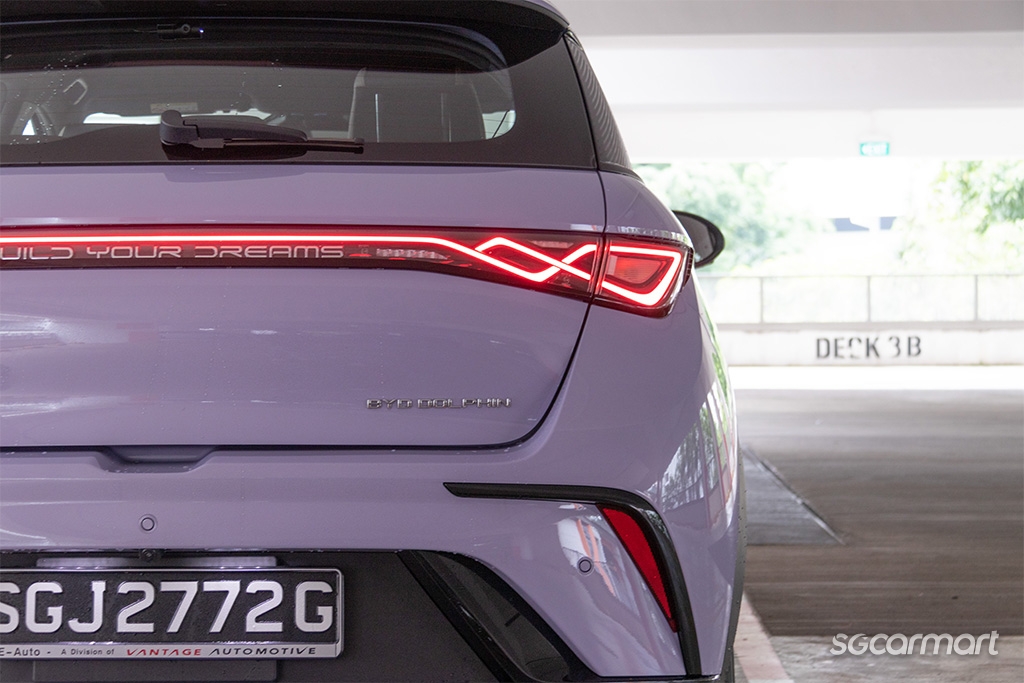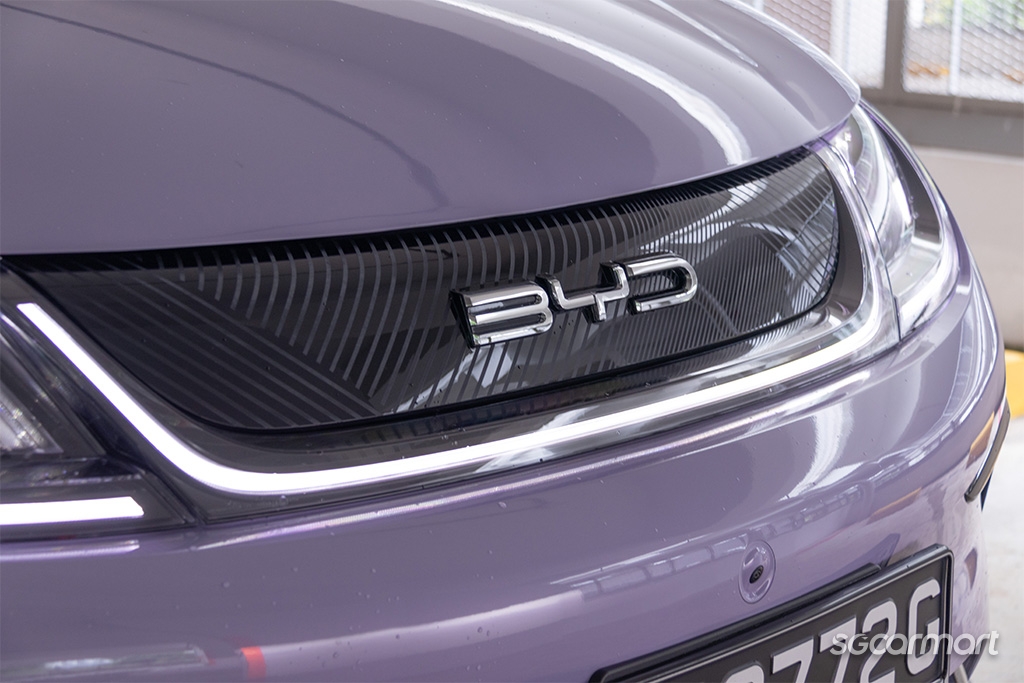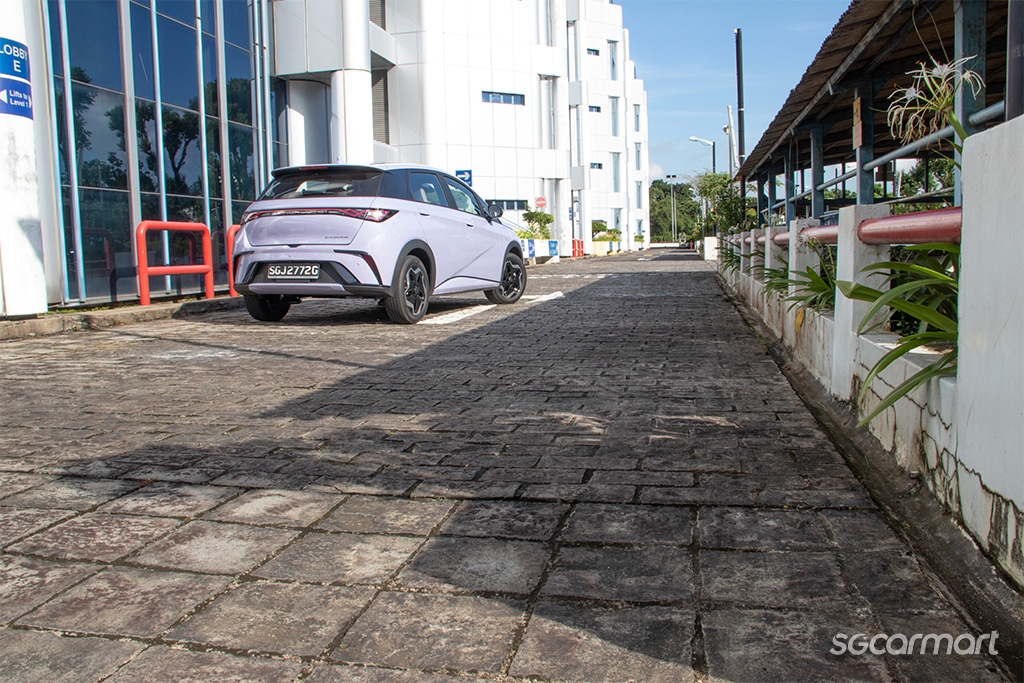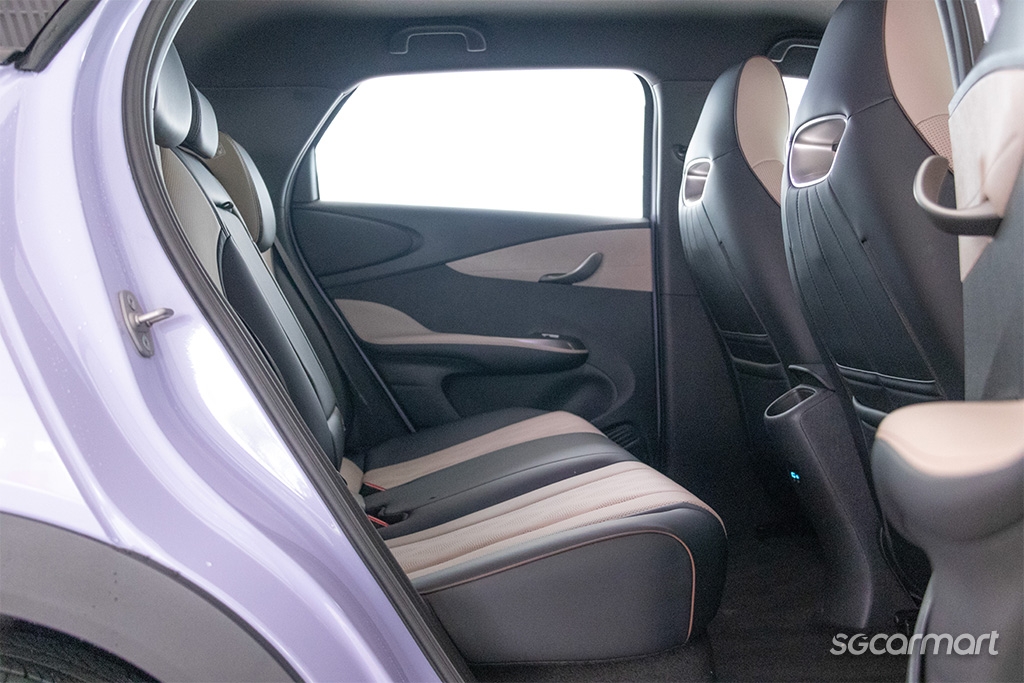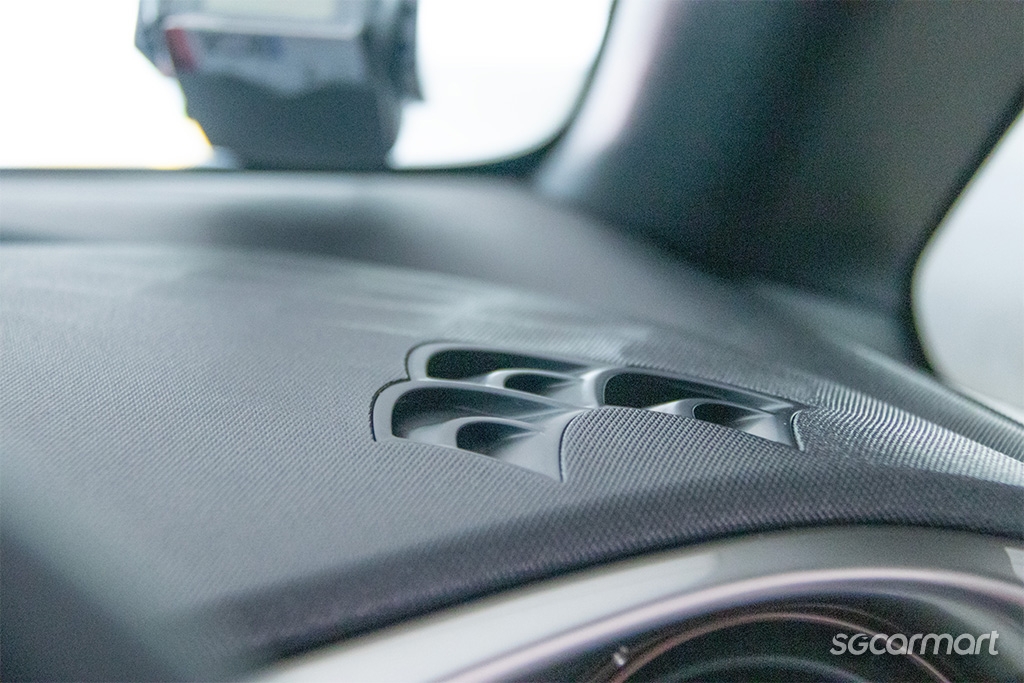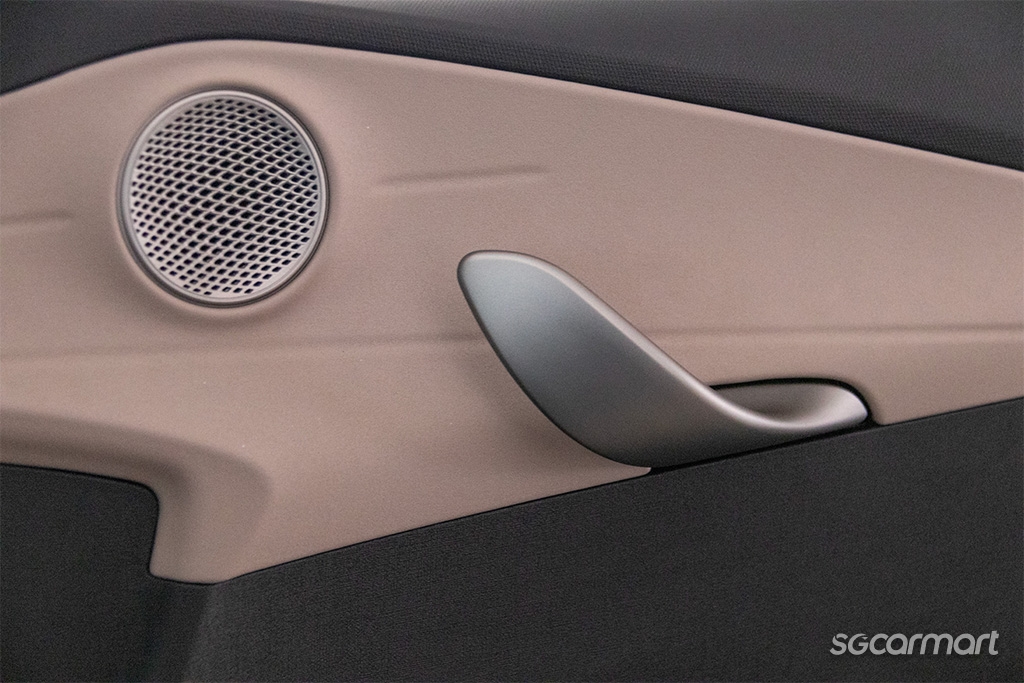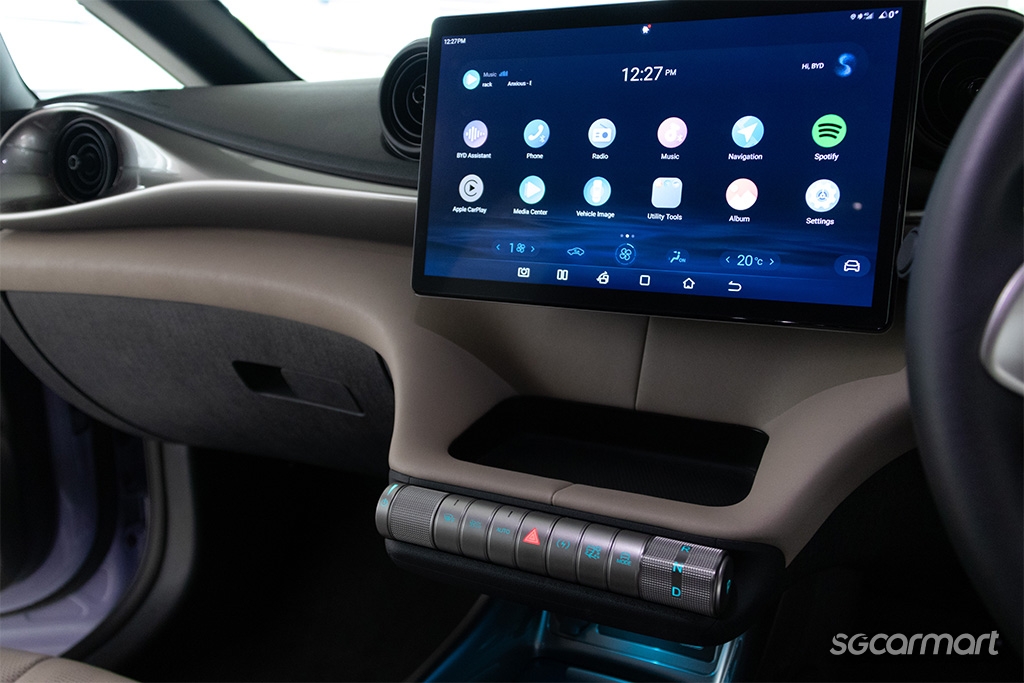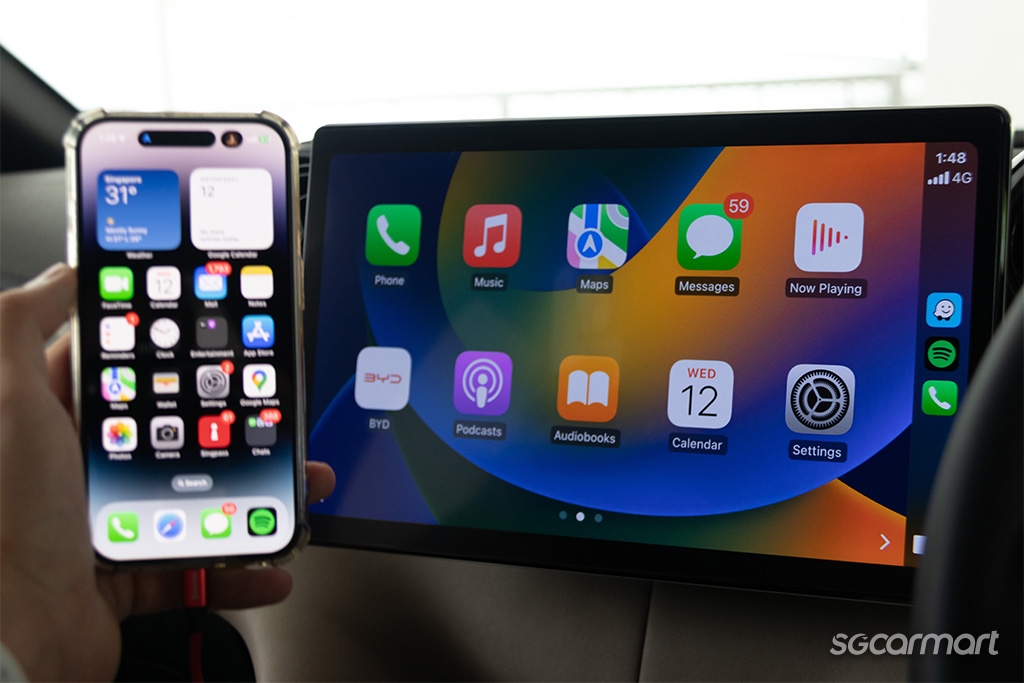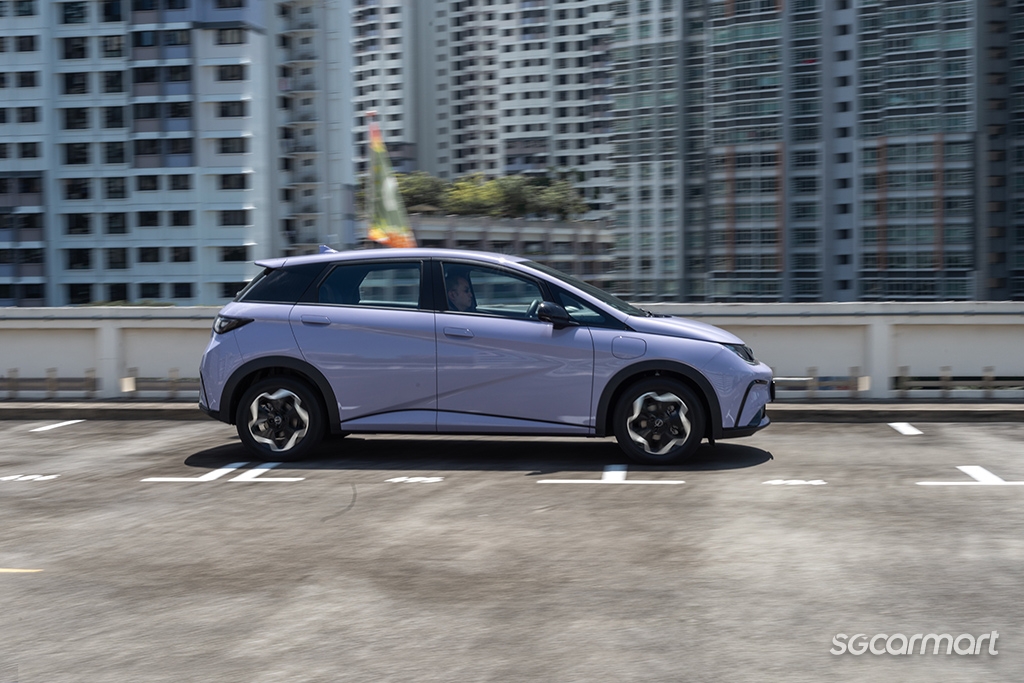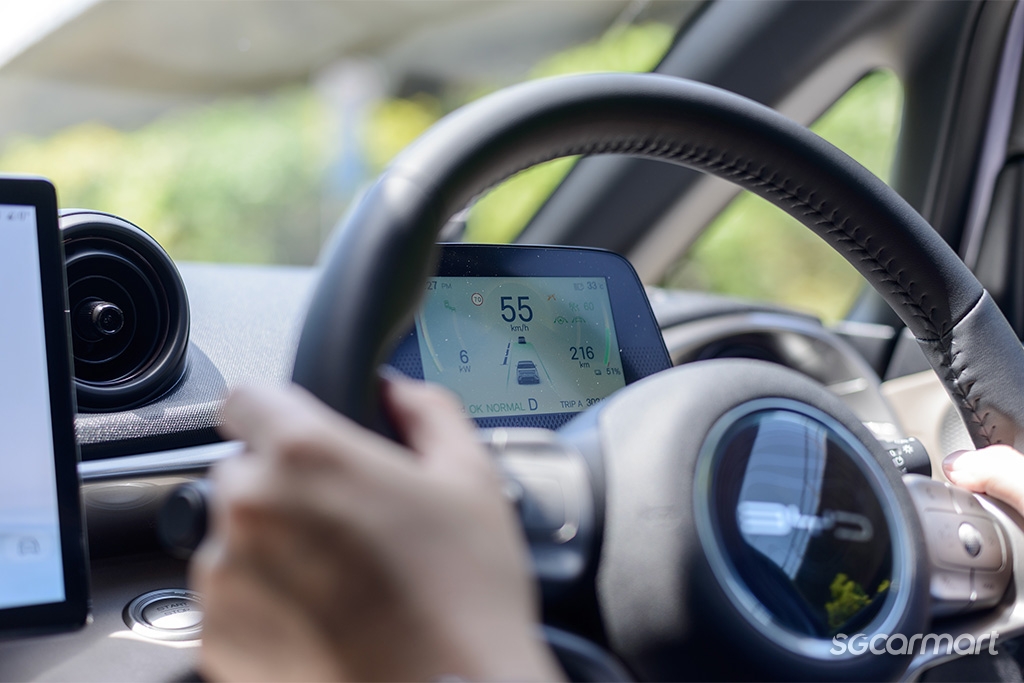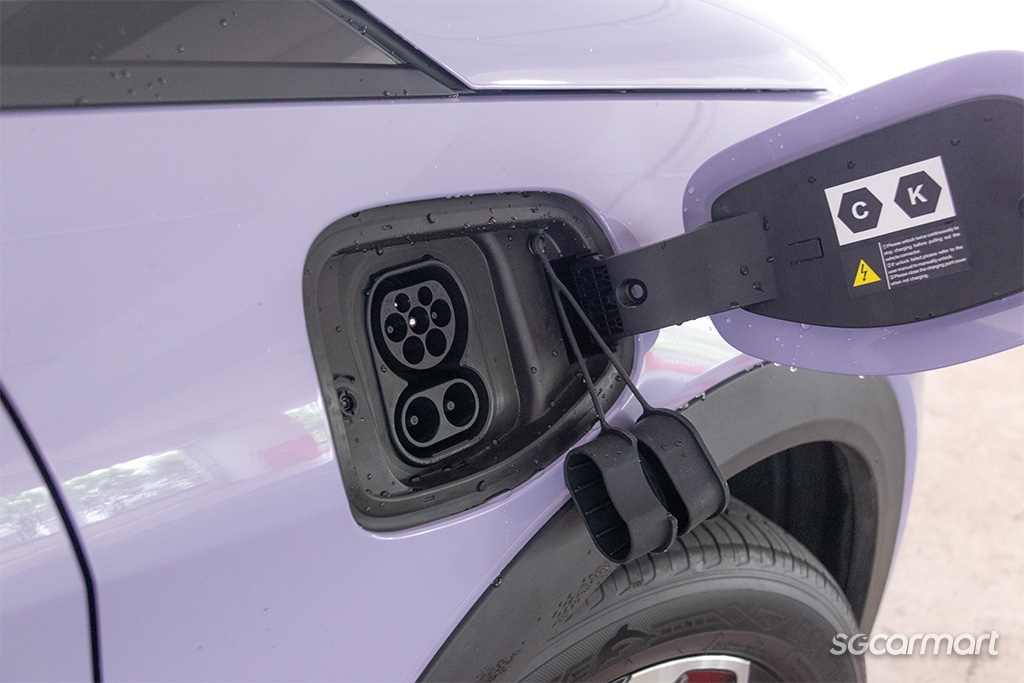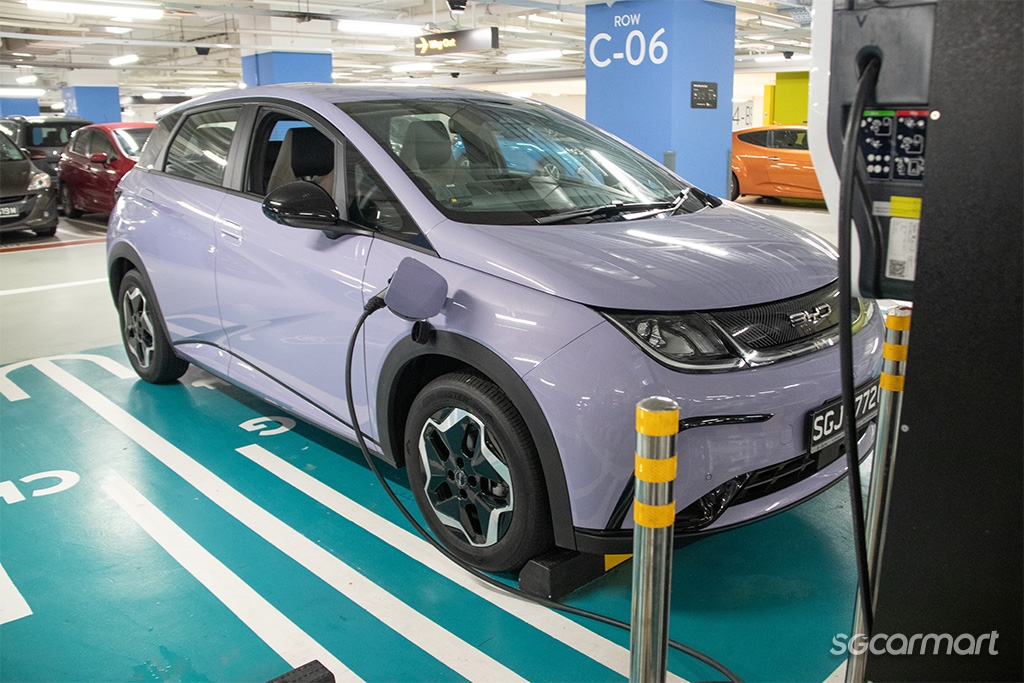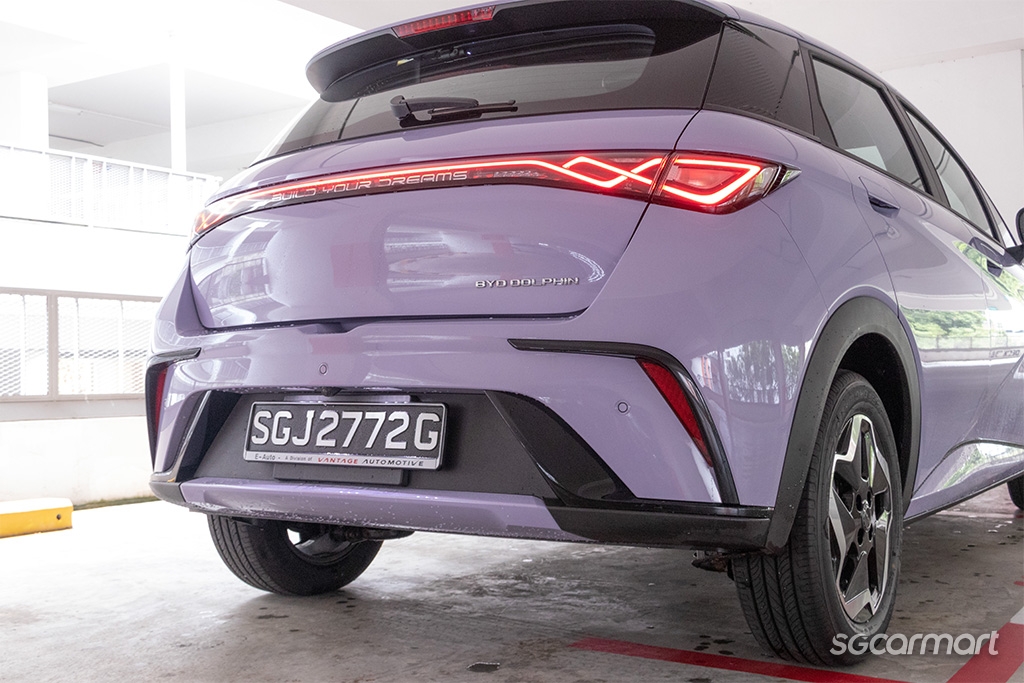BYD Dolphin 44.9kWh Review
22 Jul 2023|24,906 views
What We Like
Class-leading equipment list
Distinct styling both on the outside and inside
Generous space for rear passengers
Zippy nature; decently planted
Very commendable level of range for a car this size
What We Dislike
Build quality for central control panel could be improved
Standard drone/twinkling sound emitted while car is creeping too loud at lower speeds
Size matters, but you don't always need a big car to also make a big splash.
Look past the hunkering SUVs that dominate our roads, and one will find hatchbacks and compact sedans colouring the vital space between those bolder lines; humbler workhorses that have quietly but firmly compelled drivers with their sensibility and economy. Only in recent years has a trying COE climate thinned out the space available for such cars to thrive today.
Considering all this, it's not unfair to say that BYD is bravely swimming against the current with its latest entrant: Not a trendy crossover with black plastic, but its first ever hatchback here, called the Dolphin.
BYD says a new 'Ocean Aesthetics' philosophy (rather than 'Dragon Face' on the BYD Atto 3) was applied to the Dolphin, but the car holds your gaze first with a face that skews more towards 'robotic' than 'marine mammal-like' in feel.
Head lights sit flush with the black panel separating them, creating the impression of a single, unbroken frame up front - also a perfect inversion of the sculpted front apron underneath. Like the Atto 3, one of its most eye-catching features is a curved light strip across the front.
The marine inspiration comes into picture more clearly with the Dolphin's unique 16-inch alloys, lines running in a zig-zag pattern across the side, as well as the helixed single taillight bar at its rear. A 'floating roof' adds to the nice interplay between the various unorthodox paintcoats offered (this lilac-shade is called Maldive Purple) and an overall deference to the colour black. This is most definitely not a car you will mistake for another on the road.
The car's distinct styling and 'floating roof' are paired with unique paintcoats from the factory to help ensure it won't mistaken for something else on the road
Design aside, something else that will probably only strike you in person about the Dolphin is its height.
Park it next to a Volkswagen Golf or Mazda 3 Hatchback and you might be momentarily deceived into thinking it's the larger car - even when it's actually shorter and narrower. There's good reason, of course, for the fact that it stands 1,570mm tall: Its battery pack lies underfloor.
On that note, passenger space in the Dolphin is fantastic thanks to its electric underpinnings. Its compact proportions disguise the fact that it has a sizeable 2,700mm wheelbase, which, by the way, is a mere 20mm off that on the Atto 3, a significantly larger car overall.
As a result, kneeroom in the second row rivals that in family sedans and crossovers one segment above. Coming back to the batteries, the Dolphin's bespoke EV platform gives it a nice, flat floor. Fights for the window seats should be less pronounced, since even the middle passenger won't have to sit with raised knees.
This is still a compact car, so longer journeys in optimum comfort are best reserved for four. For Singapore's shorter journeys, however, this can be a competent five-seater.
Practicality aside, the Dolphin's marine-themed cabin surfaces delight with its watery whimsy. Vis-a-vis the athletic/energy-inspired cabin of the Atto 3, the oceanic cues are more immediately arresting, and also more visually pleasing. Sculpted lines flow outwards, then swirl around whirlpool-like vents at the dash's ends. Most charming are the door handles, which mimic a dolphin's flippers while still retaining utility since they meet one's hands nicely when opening the doors.
The marine-inspired design philosophy is made even clearer with the car's whimsical dashboard, and door handles that mimic a dolphin's flippers
The setup on the dash also mirrors exactly what one sees in the Atto 3 - including a 5.0-inch driver's display and 12.8-inch touch-operated Intelligent Rotating Display for infotainment. Bear in mind the Dolphin's entry-level positioning, and one will realise that the latter is likely one of the largest screens you'll get in the compact class.
Having so much digital real estate is an undeniable treat, and while the sheer breadth of BYD's operating system requires some time to properly get acquainted with, the expanse is ultimately not unwelcome. Perhaps due to the smaller cabin, even the further end of the screen is easily within the driver's reach, adding to the ease of use.
Storage spaces are nicely segregated inside, and while the controls could be better-weighted (especially considering their regular use), packing them together in cylindrical tubes is a neat design choice
Yet another cool feature of the dashboard is the way in which space is divided. A little tray rests just underneath the rotating screen, perfect for a wallet or smartphone; further down lies another tray that, when retracted, reveals a deeper cubby with USB (A and C) points. Finally, the 'floating' centre console hides another storage area beneath.
Integrated into this central area are the multitude of controls (including the gear lever) nicely nestled within two separate cylindrical 'tubes'. Simultaneously compact and neat, the novelty of this layout nicely blends into the rest of the design choices in the cabin - but is let down slightly by switches that lack weight and damping.
A single front motor on the Dolphin produces just 94bhp and 180Nm of instant torque, but these humbler on-paper performance figures do not do justice to the car's peppiness.
180Nm of torque, in particular, is admittedly not a large amount - not for an EV, and especially in an era where turbocharged engines have become the norm. When instantly unleashed, and all at once, however, the Dolphin still feels incredibly light on its feet.
This applies especially to the 0 to 60km/h range, which is what the average Singaporean is likely to find themselves in anyway on a regular basis. While you won't be winning light-to-light races, you also won't notice power tapering off too much unless you're actively trying to run into the Traffic Police's bad books.
Where more powerful models have made EVs almost terrifying and unreal with the amount of power they have, the Dolphin reinforces the alternate path of what an EV for the masses can feel like from behind the wheel. In equal, measured manner to the way in which power is dispensed, a gentle regenerative system means lifting off the accelerator also does not cause the car to suddenly decelerate.
The Dolphin doesn't exhibit too much roll around bends, too, despite its height, thanks to the weight of the floor-mounted batteries serving as a counter balance. While steering feel can be made heavier for more eager drivers, it's clear the Dolphin is no hot hatch - which is perfectly fine considering that it doesn't masquerade as one.
Against the overall satisfaction one is sure to feel with the Dolphin's silent comfort, a couple of minor pain points must be noted. Firstly, those factory-fitted eco-tyres somewhat dampen the Dolphin's acoustic and ride comfort. Cabin insulation also isn't exceptional.
But a bigger issue for us was the rather intrusive 'engine sound' emitted by the car at lower speeds.
Up to 30km/h, either a twinkling chime, or a mechanical drone is played to warn you that the car is actually moving; this also announces its presence to pedestrians in say, carparks. Thankfully, BYD's local dealership says this can be tweaked at its authorised workshops - and in all, these slight rougher edges are ultimately more than acceptable for a budget-oriented small hatch.
Conversely, where the Dolphin cannot be faulted is in the practicality it offers as an electric car.
The rated ranges provided by most electric carmakers - even by the stricter WLTP standard - tend to overstate how far a car can go on a single charge. But with the Dolphin, BYD has strangely done the opposite. Our driving patterns returned an energy consumption figure of around 8.3km/kWh - a good margin higher than the official 6.6km/kWh recorded.
In the real world, that means the Dolphin can get closer to 400km when its 44.5kWh battery is fully juiced up (rather than the 300km its rating suggests) - outstanding for a car its size. Best of all, fast charging with a 60kW DC outlet will bring its state-of-charge from 0 to 80% in just 40 minutes.
The ability of the Dolphin to punch above its weight is made even more incontrovertible when one considers its fully-stuffed equipment (ventilated seats for both front occupants!) and safety feature list (including adaptive cruise control and blind spot detection).
In many ways, the Dolphin pulls the same trick as the Atto 3 by first drawing you in with a distinct, and frankly rather un-car like identity (no other carmaker out there today is drawing inspiration from marine animals, dragons, or gyms). In one particular setting, the pint-sized hatch even emits the sounds of water droplets as you're shifting between 'Drive', 'Reverse' and 'Park'.
But where the picture comes together in full - and this part is arguably just as important - is when you consider the edges in practicality and value it offers over its contemporaries, both combustion-engined and all-electric.
Regarding the latter group, the only other compact electric hatchbacks you'll find on the market today skew more towards niche, halo models. The Dolphin, on the other hand, feels like a carefully-calculated product for the masses that you can live with daily - even if it's not 100% polished.
By this token, the car already feels on track to be yet another success for BYD. Today's COE waters may be choppy and murky, but all things considered, the Dolphin looks set to easily stay afloat.
Here are a few other reviews that may interest you!
We have just the thing so you can judge how much space the BYD Dolphin has to offer!
What We Like
Class-leading equipment list
Distinct styling both on the outside and inside
Generous space for rear passengers
Zippy nature; decently planted
Very commendable level of range for a car this size
What We Dislike
Build quality for central control panel could be improved
Standard drone/twinkling sound emitted while car is creeping too loud at lower speeds
Size matters, but you don't always need a big car to also make a big splash.
Look past the hunkering SUVs that dominate our roads, and one will find hatchbacks and compact sedans colouring the vital space between those bolder lines; humbler workhorses that have quietly but firmly compelled drivers with their sensibility and economy. Only in recent years has a trying COE climate thinned out the space available for such cars to thrive today.
Considering all this, it's not unfair to say that BYD is bravely swimming against the current with its latest entrant: Not a trendy crossover with black plastic, but its first ever hatchback here, called the Dolphin.
BYD says a new 'Ocean Aesthetics' philosophy (rather than 'Dragon Face' on the BYD Atto 3) was applied to the Dolphin, but the car holds your gaze first with a face that skews more towards 'robotic' than 'marine mammal-like' in feel.
Head lights sit flush with the black panel separating them, creating the impression of a single, unbroken frame up front - also a perfect inversion of the sculpted front apron underneath. Like the Atto 3, one of its most eye-catching features is a curved light strip across the front.
The marine inspiration comes into picture more clearly with the Dolphin's unique 16-inch alloys, lines running in a zig-zag pattern across the side, as well as the helixed single taillight bar at its rear. A 'floating roof' adds to the nice interplay between the various unorthodox paintcoats offered (this lilac-shade is called Maldive Purple) and an overall deference to the colour black. This is most definitely not a car you will mistake for another on the road.
The car's distinct styling and 'floating roof' are paired with unique paintcoats from the factory to help ensure it won't mistaken for something else on the road
Design aside, something else that will probably only strike you in person about the Dolphin is its height.
Park it next to a Volkswagen Golf or Mazda 3 Hatchback and you might be momentarily deceived into thinking it's the larger car - even when it's actually shorter and narrower. There's good reason, of course, for the fact that it stands 1,570mm tall: Its battery pack lies underfloor.
On that note, passenger space in the Dolphin is fantastic thanks to its electric underpinnings. Its compact proportions disguise the fact that it has a sizeable 2,700mm wheelbase, which, by the way, is a mere 20mm off that on the Atto 3, a significantly larger car overall.
As a result, kneeroom in the second row rivals that in family sedans and crossovers one segment above. Coming back to the batteries, the Dolphin's bespoke EV platform gives it a nice, flat floor. Fights for the window seats should be less pronounced, since even the middle passenger won't have to sit with raised knees.
This is still a compact car, so longer journeys in optimum comfort are best reserved for four. For Singapore's shorter journeys, however, this can be a competent five-seater.
Practicality aside, the Dolphin's marine-themed cabin surfaces delight with its watery whimsy. Vis-a-vis the athletic/energy-inspired cabin of the Atto 3, the oceanic cues are more immediately arresting, and also more visually pleasing. Sculpted lines flow outwards, then swirl around whirlpool-like vents at the dash's ends. Most charming are the door handles, which mimic a dolphin's flippers while still retaining utility since they meet one's hands nicely when opening the doors.
The marine-inspired design philosophy is made even clearer with the car's whimsical dashboard, and door handles that mimic a dolphin's flippers
The setup on the dash also mirrors exactly what one sees in the Atto 3 - including a 5.0-inch driver's display and 12.8-inch touch-operated Intelligent Rotating Display for infotainment. Bear in mind the Dolphin's entry-level positioning, and one will realise that the latter is likely one of the largest screens you'll get in the compact class.
Having so much digital real estate is an undeniable treat, and while the sheer breadth of BYD's operating system requires some time to properly get acquainted with, the expanse is ultimately not unwelcome. Perhaps due to the smaller cabin, even the further end of the screen is easily within the driver's reach, adding to the ease of use.
Storage spaces are nicely segregated inside, and while the controls could be better-weighted (especially considering their regular use), packing them together in cylindrical tubes is a neat design choice
Yet another cool feature of the dashboard is the way in which space is divided. A little tray rests just underneath the rotating screen, perfect for a wallet or smartphone; further down lies another tray that, when retracted, reveals a deeper cubby with USB (A and C) points. Finally, the 'floating' centre console hides another storage area beneath.
Integrated into this central area are the multitude of controls (including the gear lever) nicely nestled within two separate cylindrical 'tubes'. Simultaneously compact and neat, the novelty of this layout nicely blends into the rest of the design choices in the cabin - but is let down slightly by switches that lack weight and damping.
A single front motor on the Dolphin produces just 94bhp and 180Nm of instant torque, but these humbler on-paper performance figures do not do justice to the car's peppiness.
180Nm of torque, in particular, is admittedly not a large amount - not for an EV, and especially in an era where turbocharged engines have become the norm. When instantly unleashed, and all at once, however, the Dolphin still feels incredibly light on its feet.
This applies especially to the 0 to 60km/h range, which is what the average Singaporean is likely to find themselves in anyway on a regular basis. While you won't be winning light-to-light races, you also won't notice power tapering off too much unless you're actively trying to run into the Traffic Police's bad books.
Where more powerful models have made EVs almost terrifying and unreal with the amount of power they have, the Dolphin reinforces the alternate path of what an EV for the masses can feel like from behind the wheel. In equal, measured manner to the way in which power is dispensed, a gentle regenerative system means lifting off the accelerator also does not cause the car to suddenly decelerate.
The Dolphin doesn't exhibit too much roll around bends, too, despite its height, thanks to the weight of the floor-mounted batteries serving as a counter balance. While steering feel can be made heavier for more eager drivers, it's clear the Dolphin is no hot hatch - which is perfectly fine considering that it doesn't masquerade as one.
Against the overall satisfaction one is sure to feel with the Dolphin's silent comfort, a couple of minor pain points must be noted. Firstly, those factory-fitted eco-tyres somewhat dampen the Dolphin's acoustic and ride comfort. Cabin insulation also isn't exceptional.
But a bigger issue for us was the rather intrusive 'engine sound' emitted by the car at lower speeds.
Up to 30km/h, either a twinkling chime, or a mechanical drone is played to warn you that the car is actually moving; this also announces its presence to pedestrians in say, carparks. Thankfully, BYD's local dealership says this can be tweaked at its authorised workshops - and in all, these slight rougher edges are ultimately more than acceptable for a budget-oriented small hatch.
Conversely, where the Dolphin cannot be faulted is in the practicality it offers as an electric car.
The rated ranges provided by most electric carmakers - even by the stricter WLTP standard - tend to overstate how far a car can go on a single charge. But with the Dolphin, BYD has strangely done the opposite. Our driving patterns returned an energy consumption figure of around 8.3km/kWh - a good margin higher than the official 6.6km/kWh recorded.
In the real world, that means the Dolphin can get closer to 400km when its 44.5kWh battery is fully juiced up (rather than the 300km its rating suggests) - outstanding for a car its size. Best of all, fast charging with a 60kW DC outlet will bring its state-of-charge from 0 to 80% in just 40 minutes.
The ability of the Dolphin to punch above its weight is made even more incontrovertible when one considers its fully-stuffed equipment (ventilated seats for both front occupants!) and safety feature list (including adaptive cruise control and blind spot detection).
In many ways, the Dolphin pulls the same trick as the Atto 3 by first drawing you in with a distinct, and frankly rather un-car like identity (no other carmaker out there today is drawing inspiration from marine animals, dragons, or gyms). In one particular setting, the pint-sized hatch even emits the sounds of water droplets as you're shifting between 'Drive', 'Reverse' and 'Park'.
But where the picture comes together in full - and this part is arguably just as important - is when you consider the edges in practicality and value it offers over its contemporaries, both combustion-engined and all-electric.
Regarding the latter group, the only other compact electric hatchbacks you'll find on the market today skew more towards niche, halo models. The Dolphin, on the other hand, feels like a carefully-calculated product for the masses that you can live with daily - even if it's not 100% polished.
By this token, the car already feels on track to be yet another success for BYD. Today's COE waters may be choppy and murky, but all things considered, the Dolphin looks set to easily stay afloat.
Here are a few other reviews that may interest you!
We have just the thing so you can judge how much space the BYD Dolphin has to offer!
Car Information
BYD Dolphin Electric
CAT A|Electric|6.6km/kWh
Horsepower
70kW (94 bhp)
Torque
180 Nm
Acceleration
12.3sec (0-100km /hr)
Thank You For Your Subscription.
- New Waters
- Diving Inside
- Downsized Delight
- Little Big Splash



































































